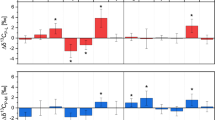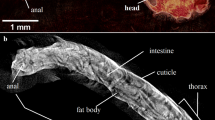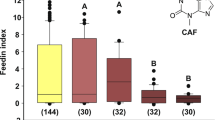Abstract
THE level of inorganic phosphorus varies in the blood of hibernating pupæ of the hawk-moth (Celerio euphorbiœ) inversely with the rate of consumption of oxygen1,2. The curve representing inorganic phosphorus values in the blood during the whole pupal stage is the reverse of the well-known U-shaped curve of oxygen consumption.
This is a preview of subscription content, access via your institution
Access options
Subscribe to this journal
Receive 51 print issues and online access
$199.00 per year
only $3.90 per issue
Buy this article
- Purchase on Springer Link
- Instant access to full article PDF
Prices may be subject to local taxes which are calculated during checkout
Similar content being viewed by others
References
Biochem. Z., 219, 473 (1930).
Biol. Zbl., 51, 259 (1931).
C.R. Soc. Biol., Paris, 121, 414 (1936).
XVII Int. Physiol. Congress, Oxford, 1947, Abstracts, p. 274.
z. vergl. Physiol., 25, 83 (1937).
Author information
Authors and Affiliations
Rights and permissions
About this article
Cite this article
HELLER, J. Phosphorus Compounds and Metabolic Rate in Insect Pupæ. Nature 163, 952–953 (1949). https://doi.org/10.1038/163952b0
Issue Date:
DOI: https://doi.org/10.1038/163952b0
This article is cited by
-
Functional characterization of the Hyles euphorbiae hawkmoth transcriptome reveals strong expression of phorbol ester detoxification and seasonal cold hardiness genes
Frontiers in Zoology (2018)
-
�ber die Verteilung des im Raupenstadium aufgenommenen 32P-Dinatriumhydro genphosphats bei der schl�pfenden Imago von Vanessa IO L.
Zeitschrift f�r Vergleichende Physiologie (1954)
-
�ber die Aufnahme von radioaktivem, sekund�rem Natriumphosphat bei Lucanus cervus L.
Zeitschrift f�r Vergleichende Physiologie (1952)
Comments
By submitting a comment you agree to abide by our Terms and Community Guidelines. If you find something abusive or that does not comply with our terms or guidelines please flag it as inappropriate.



